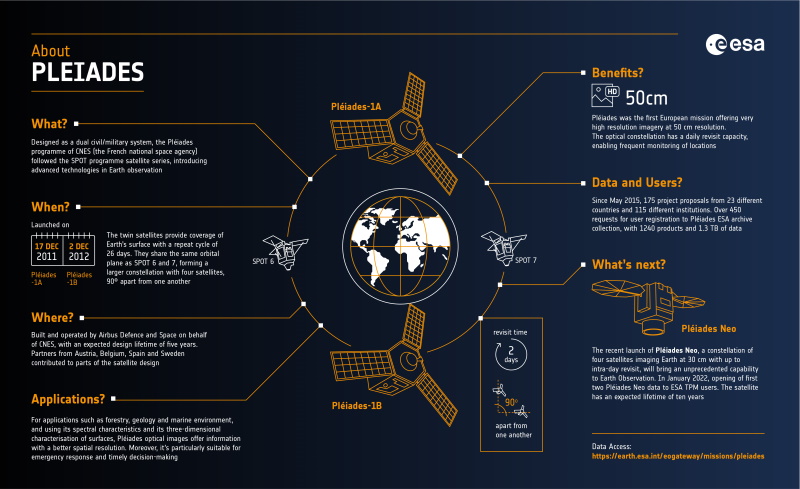- Pléiades
- Mission
- Pléiades Overview
Pléiades Overview
Mission Background
A Franco-Italian bilateral agreement, referred to as ORFEO (Optical and Radar Federated Earth Observation), was the cooperation of France and Italy on a "dual high-resolution Earth observation system", comprising a two-satellite constellation in the optical region under the leadership of France, and a four-satellite constellation under Italian leadership in the microwave region of the spectrum (initially X-band SAR). The intent of this agreement was to provide a long-term perspective on a number of high-quality data products and services on the commercial market for a wide range of applications. The dual service concept is seen in the data requirements of the defence and civilian communities with an option of a daily revisit capability. The agreement called for funding and development of the space segment by each country and a common sharing of the ground segment.
Designed as a dual civil/military system, the identical twin satellites, Pléiades-HR 1A and Pléiades-HR 1B, provide coverage of Earth's surface with a repeat cycle of 26 days. Pléiades share the same orbital plane as SPOT 6 and 7, forming a larger constellation with four satellites, 90° apart from one another.
Infographic
Learn more about the Pléiades mission, a constellation of very high resolution satellites and part of ESA's Third Party Missions programme, in this infographic:

Satellite Design
The Pléiades programme followed the SPOT programme satellite series, introducing advanced technologies in Earth observation.
| Mass | 940 kg |
| Dimensions | 1.59 m x 0.98 m x 2.24 m |
| Design Lifetime | 5 years |
Mission Operations
The two satellites operate in the same phased orbit and are offset at 180° to offer a daily revisit capability over any point on the globe.
Four ground receiving stations have been deployed for the direct downlink and archiving of imagery data with two defence centres in France and Spain. Two civil stations - one in Toulouse (France) and a polar station in Kiruna (Sweden) - receive most of the data.
Related Links
Learn more about Pleiades from these websites:
*The information provided is sourced and updated by external entities. For further details, please consult our Terms and Conditions page.